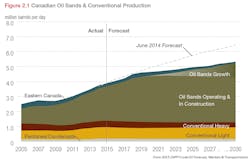CAPP: Canadian production to reach 5.3 million b/d by 2030
The Canadian Association of Petroleum Producers (CAPP) estimates production of Canadian oil will increase 43% over 16 years to 5.3 million b/d by 2030 compared with 3.7 million b/d in 2014.
CAPP’s forecast a year ago estimated oil production of 6.4 million b/d in 2030 (OGJ Online, June 10, 2014).
The two forecasts are similar during the early years of the forecast period, CAPP said. The slower pace of production in later years is the result of reduced capital spending intentions due to the sharp decline in global oil prices.
Total oil and natural gas industry capital investment in Canada is forecast at $45 billion in 2015, down nearly 40% from $73 billion in 2014. The oil sands component is forecast to be $23 billion in 2015 compared with $33 billion in 2014.
CAPP said oil sands remain the primary driver of growth in Canada, with production reaching 4 million b/d by 2030, down from 4.8 million b/d in last year’s forecast. Conventional oil production in western Canada, including condensate, is projected at 1.3 million b/d, while eastern Canadian offshore production is forecast at 91,000 b/d.
“We have the energy the world needs—our challenge is getting it there,” said Greg Stringham, CAPP vice-president for oil sands and markets. “Connecting Canada’s growing supplies to these markets safely and competitively is a top priority. Over the next 2 decades, we believe all forms of transportation will still be needed to move Canadian oil to markets to the east, west and south.”
While pipelines remain the primary transportation mode for large crude oil volumes over long periods of time, delays in startup dates for pipeline proposals mean railways will continue to be used as a complement to pipeline transportation.
“Several pipeline projects are at various stages in the regulatory process,” Stringham said. “These projects target three different markets and would provide Canadian producers with the market access necessary to become a truly global supplier.”
CAPP said refineries in Quebec and Atlantic Canada import nearly 80% of their oil from foreign sources. The US Gulf Coast refining cluster is the major potential growth market for Canadian heavy oil. There is also a strong and growing demand for Canadian oil in Washington, California, Asia, and Europe. To reach these markets, more transportation capacity and tidewater access are required, CAPP said.
CAPP’s annual forecast is developed from survey data collected in March and April.
